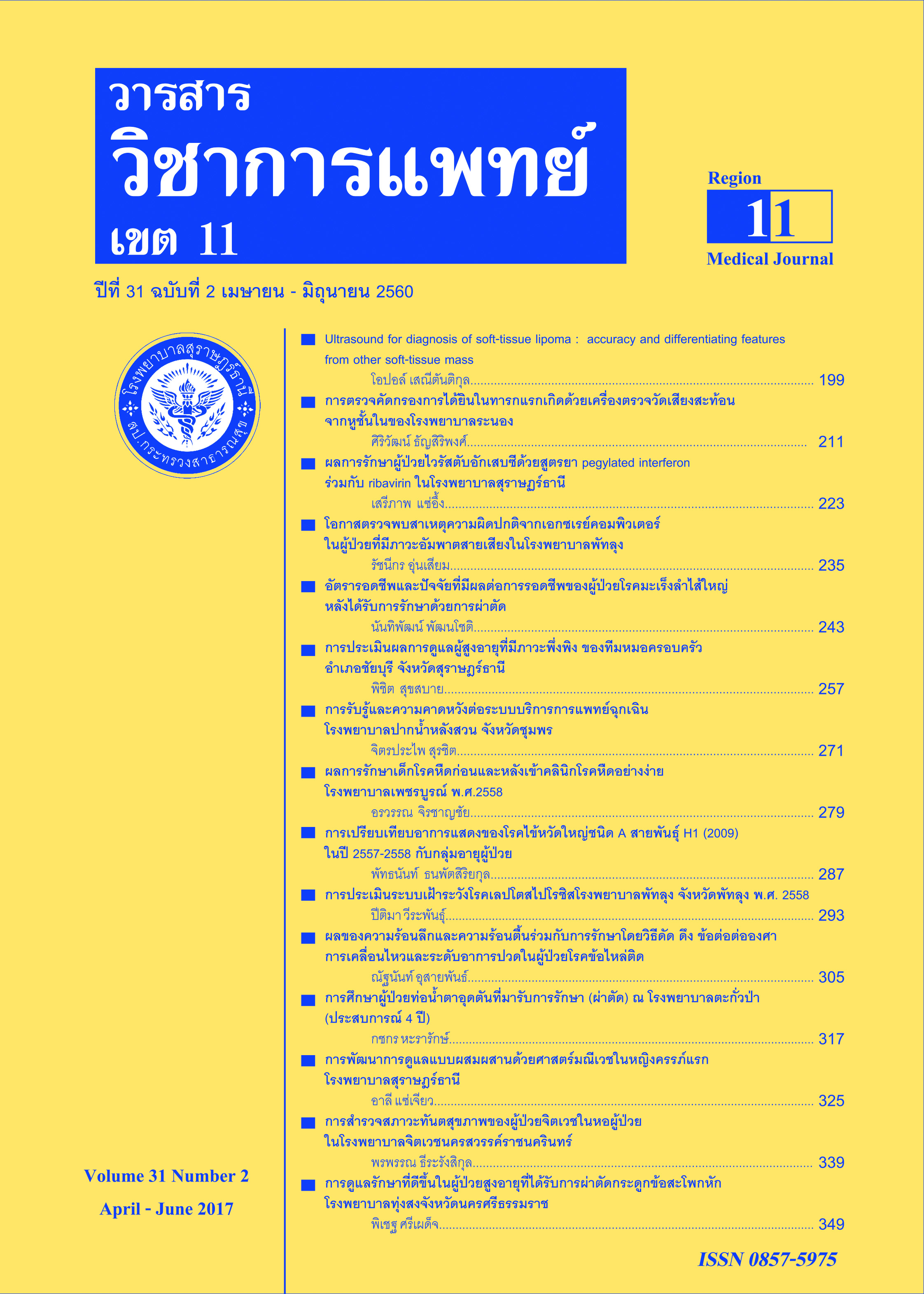The efficacy of computed tomography for detection the causes of vocal cord paralysis at Phatthalung hospital
Keywords:
Vocal cord paralysis, computed tomography, neckAbstract
Objective : To provide the percentage of computed tomography for finding the extralaryngeal cause of vocal cord paralysis.
Method : A retrospective study. The data was collected from 35 patients the present with hoarseness and were investigated by CT scans for search the extralaryngeal causes of vocal cord paralysis after undetected by laryngoscopy between February 2012 to January 2017.
Result : The overall 35 patients who have vocal cord paralysis were recruited to the present study. The mean age was 62.86 years (range 37-86 years). The main age group could be observed in 61-70 years old. The ratio of males and females was 1.9:1. 54.3% successful detected by CT scans, however 45.7% was negative finding the causes. In addition, the most common cause of extralaryngeal vocal cord paralysis was malignancy (14 cases, 40%). The detected main cause of malignant tumors consisted of four lung cancers and four lymph node metastasis. The benign condition was detected 14.3% and the main cause was thyroid disease.
Conclusion : The computed tomography can increase detected the extralaryngeal cause of vocal cord paralysis, especially in malignant of neck include upper chest.
References
2. สิริพร หิรัญแพทย์, โกวิทย์ พฤกษานุศักดิ์. เทคนิคการตรวจ CT scan ผู้ป่วยมะเร็งของศีรษะและคอที่เหมาะสม. สงขลานครินทร์เวชสาร 2549; 24(3):241-43.
3. Chen HC, Jen YM, Wang CH, Lee JC, Lin YS.Etiology of vocal cord paralysis.ORL J Otorhinolaryngol Relat Spec 2007;69:167-71.
4. Chin SC, Edelstein S et al (2003) Using CT to localize side and level of vocal cord paralysis. AJR Am J Roentgenol 180:1165–1170.
5. Christina M, Daria C. Unilateral vocal cord paralysis: A review of CT findings, Mediastinal causes, and the course of the recurrent laryngeal nerves. Radiographic 2012;32:721-740.
6. Furukawa M, Furukawa MK, Ooishi K. Statistical analysis of malignant tumors detected as the cause of vocal cord paralysis. ORL J Otorhinolaryngol Relat Spec 1994;56:161–165.
7. Glazer HS, Aronberg DJ, Lee JKT. Extralaryngeal causes of vocal cord paralysis. AJR Am J Roentgenol 1983;141:527-531.
8. Harvey S, Glazer Dixie J, Aronberg Joseph K. T. Lee Stuart S. Extralaryngeal causes of vocal cord paralysis : CT evaluation. AJR:141, September 1983: 527-531.
9. Wunderlich C, Wunderlich O, Tausche AK, Fuhrmann J, Boscheri A, Strasser RH. Ortner’s syndrome or cadiovocal hoarseness. Intern Med J. 2007;37:418-9.
10. Myssiorek D. Recurrent laryngeal nerve paralysis: anatomy and etiology. Otolaryngol Clin North Am 2004;37:25–44.
11. Paquette CM, Manos DC. Unilateral vocal cord paralysis: a review of CT findings, mediastinal causes, and the course of the recurrent laryngeal nerves. Radiographics 2012;32:721–740.
12. Sun Wha Song, Beom Cho Jun, Kwang Jae Cho, Sungwon Lee, Young Joo Kim, and Seog Hee Park. CT evaluation of vocal cord paralysis due to thoracic disease: A 10-year retrospective study. Yonsei Med J 2011;52(5):831-837.
13. Titche LL. Causes of recurrent laryngeal nerve paralysis.Arch Otolayngol 1976;102:259-61.
14. Urguhart. Idiopathic vocal cord palsies and associated neurological conditions. Arch otolaryngol head and neck Surg.2005;131(12):1086-9.
15. Yumoto E, Minoda R, Hyodo M, Yamagata T. Causes of recurrent laryngeal nerve paralysis. Auris Nasus Larynx 2002; 29(1):41–45.






